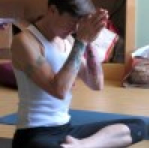There’s a beautiful set of images that’s been circulating on the interwebs the past few days—pictures of people before and after a 30-day meditation retreat (http://shambhalatimes.org/2011/10/20/before-and-after-portraits-from-dathun/). It warms your heart: all these suffering beings lifted—visibly lifted—by a month of what was no doubt rough and tumble contemplative practice. Looking at these pictures, we see something that looks a lot like hard evidence—tangible evidence of the capacity of spiritual practice to transform us. Heck, it’s writtenon these people’s faces, there for all to see.
If there’s one word that cuts across alt. spirituality circles these days, it’s Transformation. And it’s a good one. Why else practice, if not to transform, to change, to make a little headway on the one wish the Buddha so eloquently taught that we all share: the wish to suffer less?
All the practices we undertake—the sitting, the contemplation, the elaborate or simple sequences of postures, the chanting, the breathwork, the commitment to be present and attend, let alone to hew to the ethical disciplines that soften and strengthen us for change—all are challenging, even arduous in some way, no matter how much they nourish us. If they weren’t, we wouldn’t need to practice them. If 30 days of meditation is what you’re offering, you sure as sugar better have something awesome for me at the end of the month. I mean, like, a new me. Yeah. That would work. Might work, anyway.
The aspiration that holds us to the steep path of practice is the desire to transform. Without that aspiration—less than a promise but far, far more than a wish–we’d fall away. Even with that aspiration, often enough, we fall away. What keeps us coming back is a simple and profound faith, “I may be changed by all of this,” rendered into action by a simple and profound prayer, “may I be changed by all of this.”
Transformation compasses the ordinary and the miraculous. It is nothing less than metamorphosis, shape-shifting. That is, after all, exactly what these “before and after” portraits are meant to show. To prove. Transformation takes place in the form realm, the realm of persons, places, and the 10,000 things. We can, of course, transform in abstract ways, imaginary ways, but we have to believe that the transformation we seek through spiritual practice is more than a beautiful idea. If it were only that, these practices would have died out millennia ago. There’s something deeply satisfying—especially for those of us who’ve been trying to get others to jump on the meditation bandwagon—about seeing visible proof that meditation can actually do what we all say it can do: remake us, inside and out.
The Latin root of transformation, “trans,” means to go across through, over, to the other side of, beyond. There it is again, there it is exactly. We crave and are taught that we can expect movement, passage, a path from one place to another. For most of us, what we long for is a change not of place but of personhood—to transform the self, to go from being this one who suffers needlessly, pointlessly, childishly, into another one entirely. In another powerful metaphor favored by spiritual teachers of all stripes and flavors, we practice to grow up, to transform from the whining children we too often are to the mature beings we want to become.
Yet despite the orientation to an other side or a beyond, “trans” insists on the passage from as much as the passage to an elsewhere. When we forget this—when we practice to leave that messy suffering blemished child-person behind—that’s when, more often than not, we get into trouble. And as teachers, when we promise our students transformation, when we sell them a no doubt much-needed spiritual makeover as the return on their considerable investment in practice—that’s sometimes where we get into trouble, too.
Face it: Accommodation is a harder sell than Metamorphosis.
But notwithstanding the difficulty of explaining—let alone selling—the benefits of accommodation, of accommodation as transformation, the spiritual traditions speak with something pretty close to one voice when it comes to the change we’re after. We practice not to go beyond but to come home. We practice not to banish this one, this one suffering, mewling, stumbling being, but to make peace with her. We practice not to shout at ourselves and our students, “grow up!” but to ever so gently, ever so lovingly sing, “sweet child o’ mine.”
The poet Wendell Berry puts it this way, brilliantly, shockingly, in words of little more than one syllable that clang like the wake-up bell in the monastery of our own heart:
we pray, not
for new earth or heaven, but to be
quiet in heart, and in eye,
clear. What we need is here.
What we need is here.
Not … here:
The transformation we seek is laughably, impossibly, vexingly close, so close we can’t even bring it into focus most of the time as we’re peering over the rainbow, signing up for the next fire ceremony or vision quest or cleanse or asana challenge. What we seek, what we need, is right here, close enough to touch.
Those people in the pictures? They look good. At peace. In a way, yes, transformed. But what they’ve been through is not an extreme makeover but an extreme unmakeover. What you’re looking at is not a lineup of new selves. It’s a wondrous rogues’ gallery of what in zen are called Original Faces.
“The way out is the way in,” Chogyam Trungpa Rinpoche insisted. And the way in is the way home.
The Original Face Unmakeover. Sure. For that one, you can sign me up.











Read 5 comments and reply